
| myArmoury.com is now completely member-supported. Please contribute to our efforts with a donation. Your donations will go towards updating our site, modernizing it, and keeping it viable long-term.
Last 10 Donors: Anonymous, Daniel Sullivan, Chad Arnow, Jonathan Dean, M. Oroszlany, Sam Arwas, Barry C. Hutchins, Dan Kary, Oskar Gessler, Dave Tonge (View All Donors) |
| Author |
Message |
Justin Pasternak

Location: West Springfield, Massachusetts Joined: 17 Sep 2006
Posts: 174
|
 Posted: Thu 25 Jan, 2007 8:56 pm Post subject: European Bowmen/Crossbowmen Quivers Posted: Thu 25 Jan, 2007 8:56 pm Post subject: European Bowmen/Crossbowmen Quivers |
 |
|
|
How many arrows or bolts did a Medieval bowmen or crossbowmen carry in their quiver during hunting expeditions and or for warfare? Where there a vast variety of quiver sizes/shapes in medieval Europe?
|
|
  |
 |
Richard Fay

|
 Posted: Thu 25 Jan, 2007 10:09 pm Post subject: Posted: Thu 25 Jan, 2007 10:09 pm Post subject: |
 |
|
Hi Justin! 
Bundles of 24 arrows, or "sheaves", seemed to be a somewhat standard unit for arrows. Sheaves of 24 arrows are mentioned in Medieval Military Technology by Kelly DeVries and An Historical Guide to Arms & Armor by Stephen Bull. It seems longbowmen typically carried two sheaves worth of arrows.
In his work Longbow: A Social and Military History, Robert Hardy states that the archers of Edward III's reign often carried two quivers at his back. The leather spacers from the quivers that were aboard the Mary Rose, a Tudor-era ship that sunk in 1545, have about 24 holes, indicating 24 arrows were carried. So two quivers would have been two sheaves, or 48 arrows.
In Medieval Warfare, Terence Wise also states that 48 was the standard number of arrows carried by longbowmen (two sheaves or quivers worth). This is also the number stated in Arms and Armour of the Medieval Knight by David Edge and John Miles Paddock.
In Agincourt 1415: Triumph Against the Odds, Matthew Bennett states that each archer carried as many as four dozen arrows in a quiver at his waist belt, but I wonder if this number actual refers to two quivers-worth. In the same source, the author states that about a dozen bolts were carried by crossbowmen in a box-like quiver
Bowmen could also carry arrows tucked into their belts. I imagine the number carried in this fashion might have varied, although there was apparently a common saying in the Middle Ages that every English archer carried twenty-four Scots under his belt.
I hope this helped!
Stay safe!
"I'm going to do what the warriors of old did! I'm going to recite poetry!"
Prince Andrew of Armar
|
|
 |
 |
Richard Fay

|
 Posted: Thu 25 Jan, 2007 10:30 pm Post subject: Posted: Thu 25 Jan, 2007 10:30 pm Post subject: |
 |
|
Hello again!
Here's a period image from the British Library of a poet, possibly John Gower, shooting a bow. Note the arrows thrust into his belt:
 Attachment: 20.03 KB Attachment: 20.03 KB
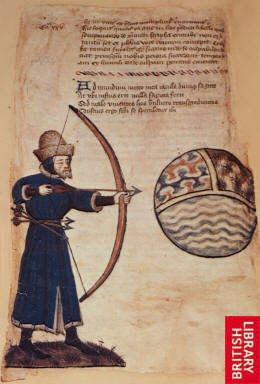
© The British Library Board
"I'm going to do what the warriors of old did! I'm going to recite poetry!"
Prince Andrew of Armar
|
|
 |
 |
|
George Hill
Location: Atlanta Ga Joined: 16 May 2005
Posts: 614
|
 Posted: Thu 25 Jan, 2007 11:05 pm Post subject: Posted: Thu 25 Jan, 2007 11:05 pm Post subject: |
 |
|
| Richard Fay wrote: | The leather spacers from the quivers that were aboard the Mary Rose, a Tudor-era ship that sunk in 1545, have about 24 holes, indicating 24 arrows were carried. So two quivers would have been two sheaves, or 48 arrows.
|
Anyone have a photo of such a quiver?
To abandon your shield is the basest of crimes. - --Tacitus on Germania
|
|
    |
 |
Patrick Brown

|
 Posted: Fri 26 Jan, 2007 2:49 am Post subject: Posted: Fri 26 Jan, 2007 2:49 am Post subject: |
 |
|
To the best of my knowledge, quivers themselves were rare for English archers between the Norman invasion and the reign of Henry VIII. Instead, arrows were carried in the belt, as shown above, or in a linen arrow bag, as demonstrated at http://www.english-longbow.co.uk/largepics/arrow%20bag.html . This is the type of receptacle found on the Mary Rose.
There is considerable evidence, however, for the use of quivers in Italy in the 14th and 15th Centuries. Apparently
Late Medieval Quivers, A Cenni, in JSAA Vol. 43, pub. 2000, is a good source for this topic, although I do not have it.
According to J.P Davies in Military archery and the Inventory of King Henry VIII, the king posessed a quiver of grene velvet embrodred with golde and the kynges armes, thother quiver of grene and white velvet, bothe furnished with shaftes. Further, the armoury at Calais had 200 quivers made of red leather, for the use of the soldiery.
Quivers for crossbow bolts appear common throughout the Medieval period, but I'm afraid I don't know much about them.
Hope some of this helps.
|
|
  |
 |
Elling Polden

|
 Posted: Fri 26 Jan, 2007 6:05 am Post subject: Posted: Fri 26 Jan, 2007 6:05 am Post subject: |
 |
|
In the norwegian laws from the 1270's, the standard number of arrows for a bow was 24, packed in two "twelves", probably linnen bags like the ones mentioned above.
It should be noted that these where not dedicated archers in the same sense as the english longbowmen; The bows came in addition to the full infantry kit of spear, shield and hand weapon.
This beeing said, it stands to reason that not all this equipment, or arrows, where worn at once.
For practical purposes, a scandinavian archer would probably put a handfull of arrows under his belt at a time, and get more when he was out.
Arrows under the belt are also less prone to spilling.
"this [fight] looks curious, almost like a game. See, they are looking around them before they fall, to find a dry spot to fall on, or they are falling on their shields. Can you see blood on their cloths and weapons? No. This must be trickery."
-Reidar Sendeman, from King Sverre's Saga, 1201
|
|
    |
 |
Justin Pasternak

Location: West Springfield, Massachusetts Joined: 17 Sep 2006
Posts: 174
|
 Posted: Fri 26 Jan, 2007 11:04 am Post subject: Posted: Fri 26 Jan, 2007 11:04 am Post subject: |
 |
|
Hey Guys thank you for your responses to the topic at hand! 
There was another question that I had that pertained to the quiver either for a bow or crossbow.
If I'm right (correct me if I'm wrong) the Longbowman was supposed to fire 6 aimed arrows per minute/12 unaimed arrows per minute and crossbowman was only able to fire 1 bolt per minute.
The question that I have to ask is to achieve the 6 aimed arrows per minute would the archer be able to draw an arrow from the quiver slung across the back, a quiver suspended from the side, or were the arrows just stuck into the ground near them for easy access?
|
|
  |
 |
Richard Fay

|
 Posted: Fri 26 Jan, 2007 2:56 pm Post subject: Posted: Fri 26 Jan, 2007 2:56 pm Post subject: |
 |
|
| Justin Pasternak wrote: | | The question that I have to ask is to achieve the 6 aimed arrows per minute would the archer be able to draw an arrow from the quiver slung across the back, a quiver suspended from the side, or were the arrows just stuck into the ground near them for easy access? |
Justin,
I've seen a lot of modern depictions and have read a lot of modern descriptions of longbowmen that claim they apparently stuck the arrows point-first into the ground, and plucked them up as they needed them. This would have the added "benefit" of creating a dirty wound when the arrow struck flesh, although this would obviously have had no effect during the actual course of a battle.
The archers under the command of Lord Fauconberg at the battle of Towton actually returned the Lancastrian arrows that had stuck into the frosty ground. He then commanded them to leave some in place as an obstacle.
They definitely used quivers by the time of Henry VIII; the leather spacers from the Mary Rose appear to have been from inside quivers. There are also period accounts of quivers in inventories; Robert Hardy cites the example of a red leather quiver and a number of quiver belts bought by John Symson of London in 1480. Like I already mentioned, Hardy listed the equipment of a longbowman in the time of Edward III, and included two quivers in the list.
In Hardy's Longbow, there is a colour photo of a reproduction Tudor quiver made by John Waller of the Medieval Society.
The quivers could have been for transport, and archers may have stuck the arrows in their belts or in the ground for actual combat. Some English archers were mounted (for transport, not for battle), and the quivers could have been left attached to the saddles.
By the way, another source that may support "two sheaves" (48 arrows) as standard issue for English longbowmen is the excerpt from Edward III's orders to the sheriff of Oxfordshire and Berkshire and other sheriffs to purchase a specified number of bows, bow strings, and arrows for the army in France in 1346. From the sheriff of Oxfordshire and Berkshire the king required 200 boxs and 400 sheaths of arrows, a two-to-one ratio. The others sheriffs were to provide more or less arrows per bow, but a few of the ratios are also close to two-to-one. Obviously, an army would need more than just was was issued to individual bowmen, but I found these numbers to be intriguing.
I hope this helped!
Stay safe!
"I'm going to do what the warriors of old did! I'm going to recite poetry!"
Prince Andrew of Armar
|
|
 |
 |
Richard Fay

|
 Posted: Fri 26 Jan, 2007 4:49 pm Post subject: Posted: Fri 26 Jan, 2007 4:49 pm Post subject: |
 |
|
Hello again!
I have found one period image depicting a bowman's quiver from Europe. It's from signs related to astrology, from a late 14th century manuscript from Burgundy or the Netherlands. It's a translation from a Perisan source, so the bow may have some Islamic influence. However, there is a definite quiver hanging from the bowman's arm.
I also found a couple more period images showing arrows thrust through the belt. One shows a lady hunting rabbits; showing how the arrows may have been carried while hunting. The next image shows a siege scene, depicting arrows carried in the same fashion in war.
Here's the image information:
| The British Library wrote: |
Record Number: 5879
Shelfmark: Sloane 3983
Page Folio Number: f.13
Description: [Whole folio] Various signs and symbols relating to astrology. Drawings include a dolphin; bear's head; man in armour with bow, arrow, and quiver; harp; hurdy-gurdy; viola; and boat with barrels and oar. From a translation of a Persian astrological treatise
Title of Work: Liber Astrologiae
Author: Jafar ibn Muhammad [Abu Mashas]; Georgius Zothori Zapari Fenduli G., translator
Illustrator: -
Production: Burgundy or S. Netherlands; second half of 14th century
Language/Script: Latin / -
Record Number: c3351-04
Shelfmark: Yates Thompson 13
Page Folio Number: f.68v
Description: [Miniature only] A lady shoots a bolt at a rabbit, which remains seated beside a rabbit hole Title of Work: Taymouth Hours
Author: -
Illustrator: -
Production: England [London?], between 1325 and 1335
Language/Script: Latin and French / - |
| The National Library of the Netherlands wrote: |
The Hague, MMW, 10 A 17
Contents: Jehan de Courcy, La Bouquechardière
Place of origin, date: Rouen (text), Carlat (illumination); before 1477
Material: Vellum, ff. 365, 420x319 (280x196) mm, 2 columns, 54 lines, littera hybrida. French. Binding: 18th-century red morocco, gilt
Decoration: 6 two-column miniatures (173/158x200/197 mm); 1 illustration in the margin; decorated initials with border decoration (ff. 1r, 2r, 2v, 3v, 4r, etc.)
Provenance: written for Jacques d''Armagnac, duke of Nemours and probably presented to Tannegui du Châtel (d. 1477). Château d''Anet (catalogue of 1724); G. Dubois, his sale in 1725 at Swart & De Hondt, The Hague (cat. 27 Aug., pt. I, no. 5394), where purchased by J. Meerman the Elder; by inhertitance to his son G. Meerman (d. 1771) and grandson J. Meerman (d. 1815); purchased in 1824 at the Meerman sale (lot 849) by W.H.J. van Westreenen |
Enjoy! 
 Attachment: 88 KB Attachment: 88 KB
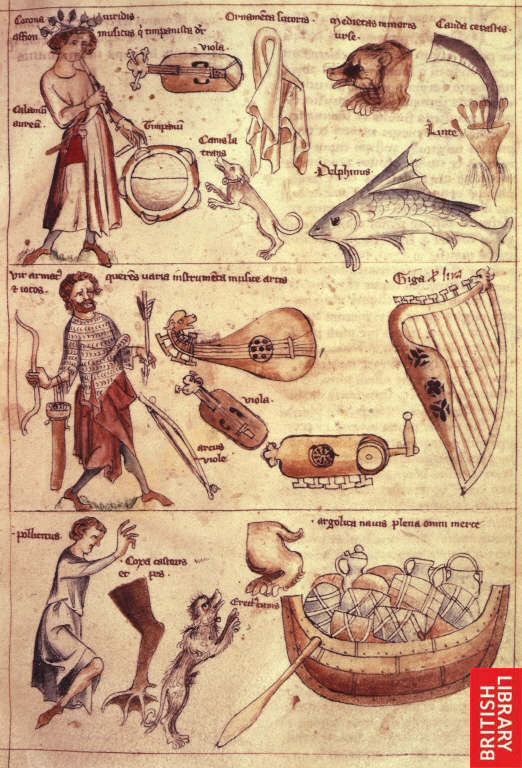
© The British Library Board
 Attachment: 81.66 KB Attachment: 81.66 KB
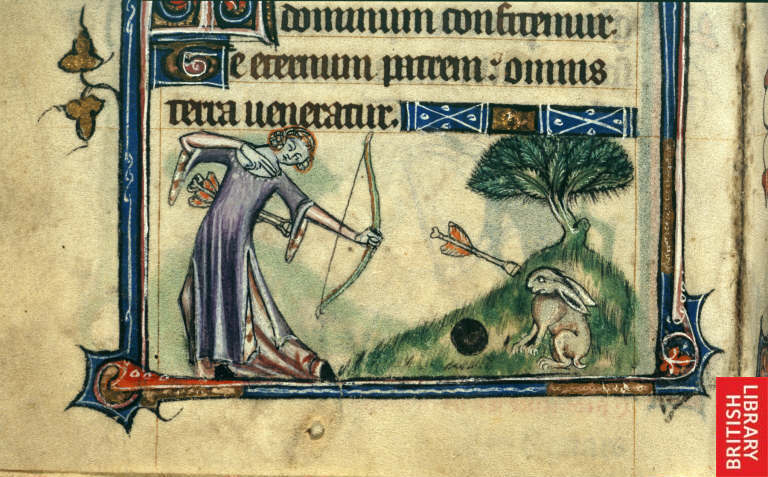
© The British Library Board
 Attachment: 58.95 KB Attachment: 58.95 KB
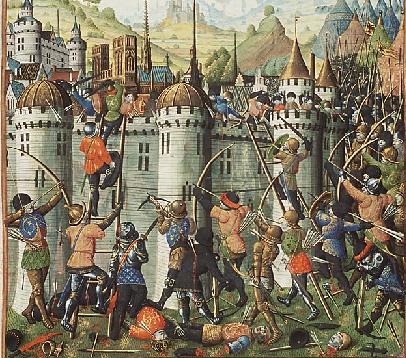
© Koninklijke Bibliotheek National Library of the Netherlands
"I'm going to do what the warriors of old did! I'm going to recite poetry!"
Prince Andrew of Armar
|
|
 |
 |
Richard Fay

|
 Posted: Sat 27 Jan, 2007 12:14 pm Post subject: Posted: Sat 27 Jan, 2007 12:14 pm Post subject: |
 |
|
Hello all!
It does appear that quivers are extremely rare in medieval iconography. I did find one Italian image from the Renaissance, circa 1500, showing a pair of archers with quivers.
I could keep looking, but most medieval manuscript images showing archers in action either neglect to show the supply of arrows, or show the arrows tucked in the belt or on the ground.
Here's the information from the British Library:
| Quote: |
Record Number: 18925
Shelfmark: Yates Thompson 29
Page Folio Number: f.132v
Description: [Whole folio] Hours of the Holy Ghost. St. Sebastian tied on a tree from which the branches have been lopped, with two angels. Two archers draw their bows to shoot, each has a quiver of arrows. Set in a green landscape with water and hills in the distance. Borders of symmetrical acanthus decoration, with jewelled corner and centre-pieces
Title of Work: Hours of Bonaparte Ghislieri
Author: -
Illustrator: Vannucci, Petro, al. Perugino
Production: Italy [Bologna]; circa 1500
Language/Script: Latin / - |
 Attachment: 30.7 KB Attachment: 30.7 KB
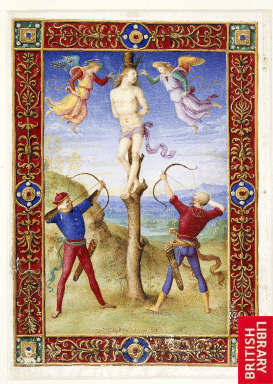
© The British Library Board
"I'm going to do what the warriors of old did! I'm going to recite poetry!"
Prince Andrew of Armar
|
|
 |
 |
Richard Fay

|
 Posted: Sat 27 Jan, 2007 12:38 pm Post subject: Posted: Sat 27 Jan, 2007 12:38 pm Post subject: |
 |
|
Hello again!
I just wanted to clarify that the leather spacers from the Mary Rose wreck aren't necessarily from quivers; I made that assumption, but it probably a false assumption. They are spacers for a sheaf of twenty-four arrows. Actually, the drawing in the upper portion of the photo in Robert Hardy's Longbow shows the arrows loosely in the spacer. The spacers themselves do not indicate the presence of a quiver. I made a connection that isn't necessarily there, basing my assumption in part on the reproduction Tudor quiver made by John Waller of the Medieval Society shown in the colour plates in the same work. (I really should watch how late at night I post replies - my mind doesn't always work at its best late at night.)
I would actually say that the arrows were more commonly carried loosely in the belt, as is shown in several manuscript images. Quivers appear to have been used (at least by 1480), but they might not have been the common way to carry arrows into actual battle.
I hope this cleared things up a bit!
Stay safe!
"I'm going to do what the warriors of old did! I'm going to recite poetry!"
Prince Andrew of Armar
|
|
 |
 |
Dan Howard

|
 Posted: Sat 27 Jan, 2007 1:12 pm Post subject: Posted: Sat 27 Jan, 2007 1:12 pm Post subject: |
 |
|
|
In Eastern Europe, quivers held much higher numbers of arrows because they were often stored point up. Maurice's Taktica mentions cavalry quivers of 40 arrows.
|
|
  |
 |
Richard Fay

|
 Posted: Sat 27 Jan, 2007 1:34 pm Post subject: Bayeux Tapestry quivers Posted: Sat 27 Jan, 2007 1:34 pm Post subject: Bayeux Tapestry quivers |
 |
|
Hello again!
As I was searching through some medieval iconography, I forgot one of the most famous works of period art depicting battle scenes. The Bayeux Tapestry shows some archers along the margins in the section depicting the battle of Hastings. This part may be a more recent restoration, but some of the archers are shown with quivers at their sides. There are also some free-standing quivers just placed between archers. If this is not a post-medieval restoration, then at least some archers at Hastings may have used quivers. I find it hard to believe that they would have had quivers in 1066, but not in 1346, 1356, 1415, and so on.
Here's an interesting description of the archers in battle at Crecy, from Robert Hardy's Longbow:
| Robert Hardy wrote: |
The archers nocked and drew, closing their backs, opening their chests, pushing into their bows, anchoring for a second, holding the drawn arrows firm, thumbs of their drawing hands touching right ears or the points of jaws as they aimed for a heartbeat when the drawn shafts slid past their bow hands until the cold steel of the arrowheads touched the first knuckles; letting fly, right hands following the strings almost as swiftly as the shafts' flight past the brown bows, grabbing the next from ground or belt or quiver, to nock and draw and anchor and loose, in deadly unrelenting repetition. |
I just thought I would add this bit because I found this passage to be evocative. Maybe I'm just a romantic at heart! 
Here are the images from the Bayeux Tapestry:
 Attachment: 23.18 KB Attachment: 23.18 KB

Archers with quivers fom the Bayeux Tapestry.
 Attachment: 17.79 KB Attachment: 17.79 KB

Archers and quivers from the Bayeux Tapestry.
"I'm going to do what the warriors of old did! I'm going to recite poetry!"
Prince Andrew of Armar
|
|
 |
 |
Richard Fay

|
 Posted: Sat 27 Jan, 2007 2:46 pm Post subject: Posted: Sat 27 Jan, 2007 2:46 pm Post subject: |
 |
|
Hello again!
I found a couple more possible pre-Tudor quivers used by archers in war. I couldn't find the original images, only drawings of the manuscript images, so there could be some question of accuracy. However, at least one is to be found in two sources, and sources that don't seem to play "fast and loose" with the details in their drawings.
The first is a mounted armoured archer with a sugar-loaf great helm, from Roy. MS. 20, D. i. fol. 127: Histoire Universelle and other tracts, circa 1290. The mounted archer, in full knightly armour except for the fact that his hands are bare, wears a quiver at his side. This figure appears in both John Hewitt's Ancient Armour and Weapons, and in Charles Henry Ashdown's Euorpean Arms & Armor. Both are older sources, but the line drawings in both are fairly well done, and seem fairly accurate when compared to other sources.
The second figure depicting a warrior with a quiver is in Ralph Payne-Gallwey's The Book of the Crossbow. This image is taken second or third hand, from the original, so it's accuracy may be in doubt, but I'm including it in case it is an accurate copy of the period image. It is from Manuscript No. 2813 in the National Library, Paris, reproduced by J. Quicherat in History of Costume in France. This illustration, of circa 1370, depicts a kneeling crossbowmen preparing to pull back his bowstring with a belt-claw to bend his bow, with an archer standing behind him. The archer appears as if he just loosed a shaft. There is a rather short quiver (his bow is also rather short - but it's definitely not a crossbow) at the archer's side, hanging by a strap or hook off a ring on his belt.
These images, if accurate, may indicate that quivers were indeed used rarely by archers throughout the middle ages.
I hope this was of interest!
Stay safe!
"I'm going to do what the warriors of old did! I'm going to recite poetry!"
Prince Andrew of Armar
|
|
 |
 |
Steven H

|
 Posted: Sat 27 Jan, 2007 2:59 pm Post subject: Posted: Sat 27 Jan, 2007 2:59 pm Post subject: |
 |
|
| Dan Howard wrote: | | In Eastern Europe, quivers held much higher numbers of arrows because they were often stored point up. Maurice's Taktica mentions cavalry quivers of 40 arrows. |
Dan-
What is the relation between storing them point up and carrying more? (It seems to me that fitting more fletchings in the quiver would be harder than fitting more points)
I must also assume other differences in the quiver design (a design like the linked above would be impossible to draw arrows from if they were point up), so I'm curious if you could expand upon that.
Thanks.
Kunstbruder - Boston area Historical Combat Study
|
|
   |
 |
Richard Fay

|
 Posted: Sat 27 Jan, 2007 4:47 pm Post subject: Posted: Sat 27 Jan, 2007 4:47 pm Post subject: |
 |
|
Hello again!
In case anyone is interested, there is one antique crossbow quiver in the albums here:
http://www.myArmoury.com/albums/photo/2208.html
Note that it's not overly wide compared to arrow quivers. Since quarrels or bolts were thicker than arrows for bows, I suspect that fewer bolts could be carried in a crossbow bolt quiver of this nature than a comparably-sized (width-wise) arrow quiver.
I've seen images of medieval crossbow quivers covered in some sort of hair or fur (I think one may have been wolf's fur), but I couldn't find any of these on-line. There is one image of these in a colour plate in Robert Hardy's Longbow. This late medieval illustration is from the Hours of Catherine of Cleves, circa 1440. It shows longbows, crossbows, a centre-shot bow, arrows, bolts, quivers, and bolt bags(?). I think what are called quivers here may be quivers for the crossbow bolts, not necesaarily the longer arrows. Whichever they may truly be, they are definitely covered in a grey fur of some sort.
Stay safe!
"I'm going to do what the warriors of old did! I'm going to recite poetry!"
Prince Andrew of Armar
|
|
 |
 |
Dan Howard

|
 Posted: Sun 28 Jan, 2007 12:32 am Post subject: Posted: Sun 28 Jan, 2007 12:32 am Post subject: |
 |
|
| Steven H wrote: | Dan-
What is the relation between storing them point up and carrying more? (It seems to me that fitting more fletchings in the quiver would be harder than fitting more points)
I must also assume other differences in the quiver design (a design like the linked above would be impossible to draw arrows from if they were point up), so I'm curious if you could expand upon that. |
Russ Mitchell would be the man to ask about detail. I just read snippets of things and seem to be able to recall them even if I read them years ago. Horse archers used bows differently to infantry. Range was shorter and direct fire was more common. Arrows stored upside down means that the fletchings would have to be small - reducing range. And they would likely get damaged - reducing accuracy. Not much of problem for horse archers but big problem for infantry archers.
|
|
  |
 |
Richard Fay

|
 Posted: Tue 30 Jan, 2007 2:29 pm Post subject: Crossbow quiver from Manesse Codex Posted: Tue 30 Jan, 2007 2:29 pm Post subject: Crossbow quiver from Manesse Codex |
 |
|
Hello all!
I found an image of a crossbow quiver in a folio from the 1305-1340 manuscript the Manesse Codex. It's worn by a hunter using a crossbow.
 Attachment: 53.6 KB Attachment: 53.6 KB
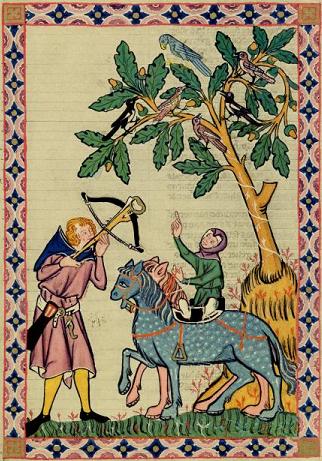
© 2004 Copyright Universitätsbibliothek
Heidelberg
"I'm going to do what the warriors of old did! I'm going to recite poetry!"
Prince Andrew of Armar
|
|
 |
 |
|
Eric Myers
Location: Sacramento, CA Joined: 23 Aug 2003
Posts: 214
|
 Posted: Tue 30 Jan, 2007 2:52 pm Post subject: linen arrow bags Posted: Tue 30 Jan, 2007 2:52 pm Post subject: linen arrow bags |
 |
|
Regarding the linen arrow bags/quivers, Historic Enterprises makes one also, but theirs is slightly different than the one pictured at the www.english-longbow.co.uk site mentioned above. I think (based on my recollection of pictures no longer on their website) that the HE spacer is not sewn into the bag and fits over the nocks behind the fletching, and thus allows for any type of arrowhead, while in the other the arrowheads must pass through the holes in the spacer so it is limited to bodkins.
In either of these, the front is untied, or possibly retied loosely behind the arrowheads, and the arrows are drawn out through the front, point first, just like you draw them out of your belt. It's a pretty cool system for carrying arrows, and allows for easy passage through undergrowth in a similar way to some Native American quivers. If you haven't tried the arrows-in-the-belt thing, you should, it's really easy, convenient, and surprisingly safe. It doesn't work as well with belt loops though, so be a dork and wear your belt over your shirt, like you would over a tunic :-P
Eric Myers
Sacramento Sword School
ViaHup.com - Wiki di Scherma Italiana
|
|
  |
 |
|
Lafayette C Curtis
|
 Posted: Sun 28 Dec, 2008 3:42 am Post subject: Posted: Sun 28 Dec, 2008 3:42 am Post subject: |
 |
|
| Richard Fay wrote: | | I have found one period image depicting a bowman's quiver from Europe. It's from signs related to astrology, from a late 14th century manuscript from Burgundy or the Netherlands. It's a translation from a Perisan source, so the bow may have some Islamic influence. However, there is a definite quiver hanging from the bowman's arm. |
Interesting. That's quite a strange placement for a quiver, though, and since you mention that it's a translation from Persian, I'm wondering if it's just a European artist's misinterpretation of Middle Eastern techniques for holding spare arrows in the string or bow hand?
| Steven H wrote: | | Dan Howard wrote: | | In Eastern Europe, quivers held much higher numbers of arrows because they were often stored point up. Maurice's Taktica mentions cavalry quivers of 40 arrows. |
Dan-
What is the relation between storing them point up and carrying more? (It seems to me that fitting more fletchings in the quiver would be harder than fitting more points)
I must also assume other differences in the quiver design (a design like the linked above would be impossible to draw arrows from if they were point up), so I'm curious if you could expand upon that. |
Yes, it's a different design altogether--often known as the "closed quiver":
http://www.atarn.org/islamic/bede/CLOSED%20QUIVER2001.htm
|
|
  |
 |
|
|
You cannot post new topics in this forum
You cannot reply to topics in this forum
You cannot edit your posts in this forum
You cannot delete your posts in this forum
You cannot vote in polls in this forum
You cannot attach files in this forum
You can download files in this forum
|
All contents © Copyright 2003-2024 myArmoury.com — All rights reserved
Discussion forums powered by phpBB © The phpBB Group
Switch to the Basic Low-bandwidth Version of the forum
|

